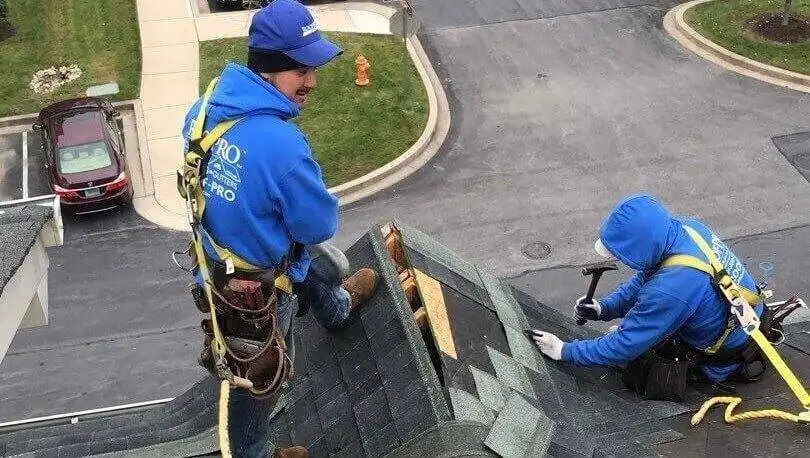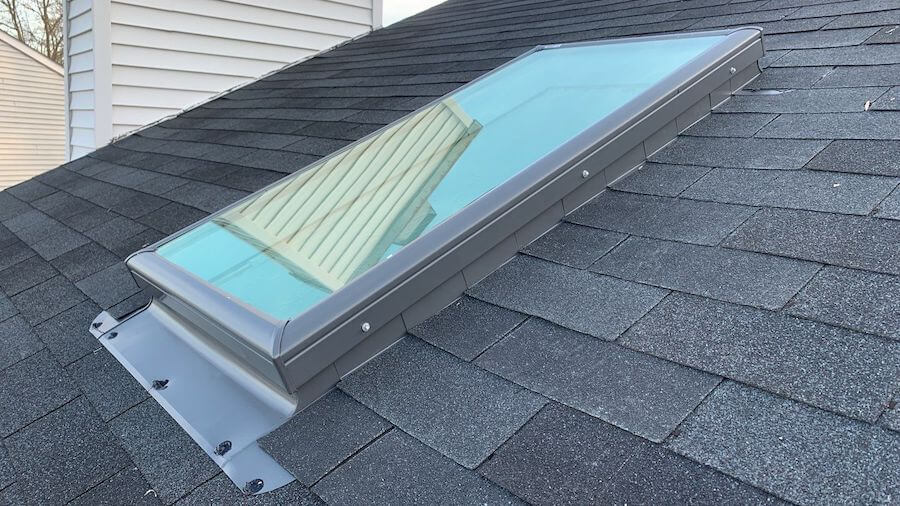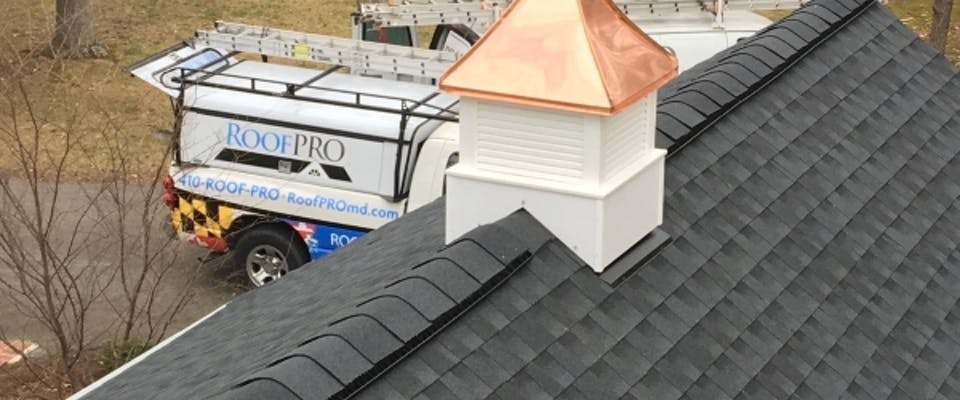Experiencing a leaking roof during heavy rain but not a light or normal rainfall can be a troubling proposition for any homeowner. It’s a clear indication that where the water is entering the home is not a normal leak.
Heavy rain can cause larger amounts of rainwater to flood parts of the roof that overwhelm the roofing system. There could be an existing roof problem, or the flashing in that area is not equipped to handle the larger amount of rain.
If your roof is only leaking during heavy storms, it’s not random; it’s telling you that part of your roofing system is holding rainwater longer than it should or failing to drain properly.
When either of these situations occurs, there are ways to properly repair the roof leak. Read on or contact our team at RoofPRO today to learn more.

Roof Leaks Can Be Caused by a Myriad of Reasons
Leaks that spring up during heavy rainstorms are typically not random; they are often the result of specific vulnerabilities or water damage in your roofing system. These reoccurring leaks can be a result of normal wear and tear over time or newer damages; understanding the various reasons behind the leaking is the first step towards remediation and preventing future damage to your property!
As stated above, finding the root cause of a leaky roof during heavy rainfall is important for stopping the issue altogether. RoofPRO is proud to offer complimentary inspections and estimates for roof leak repairs and roof replacement in Maryland! Contact us today to schedule your inspection, or read on to learn more about the common causes that cause reoccurring roof leaks.
Water Concentrated to One Location (Roof Valleys)
One of the most common reasons leaks appear only during heavy rain is due to abnormal amounts of rainwater directed to one specific point of the roof. These areas, such as roof valleys or flashing along the walls, become overwhelmed by high volumes of rainwater and eventually leak.
For example, consider a situation where a gutter downspout empties onto a lower roof section. This scenario adds water from the upper roof to the lower one, which may already be handling a significant amount of its own runoff. This concentrated flow can overwhelm the shingles or cause flashing damage, leading to leaking.
Roof Flashing Failures
Roof flashing is a vital roofing component that plays a crucial role in preventing leaks at transitions and penetrations throughout the system. These transitions include areas where the roof meets walls, a chimney, a skylight, a pipe, and other elements.
Proper flashing installation involves integrating the material with the underlying roofing material and then extending it up the vertical surface (wall, chimney, etc.) before being covered by siding or other exterior finishes. This creates a watertight seal that prevents leaking.
However, poorly installed flashing can leave gaps. These gaps become vulnerable points during heavy rain, allowing rainwater to accumulate and seep into the roof system. With lighter rainfall, the level may not reach these weak points, explaining why leaking might only occur during heavy downpours.
Damaged or Missing Shingles
One of the most common reasons for leaking is missing or broken shingles. When a shingle cracks, curls, or blows off, it exposes the underlayment beneath it. During heavy rain, this unprotected area allows water to seep through and eventually reach your attic or ceiling.
Multi-Layered Roofs and Hidden Paths
Some roof leaks appear only during heavy rains because of the path the water takes before entering your dwelling. Roofs with multiple layers can delay the leak’s appearance because water must penetrate each layer before reaching the attic. Once inside, the moisture may travel a significant distance through insulation and even drywall before becoming evident. This slower movement means lighter rain events might not generate enough volume to overcome the travel distance. However, heavier rains allow more moisture to accumulate and ultimately reach the interior, revealing the leak.

Wind-Driven Storm
Another factor influencing leak occurrence is wind direction. While wind itself doesn’t normally cause leaks on properly installed roofs, it can exacerbate existing vulnerabilities or deficiencies in the flashing, shingle, or other roof components. When strong winds blow from a specific direction, they can drive rain at an angle, forcing water into areas that might not be exposed during normal rainfall. This can lead to leaks appearing only during wind-driven rainstorms and seemingly isolated to specific wind directions.
Clogged Gutters and Downspouts
When gutters clog with leaves and debris, rainwater has nowhere to go. Instead of draining off the roof, it backs up and seeps under shingles or flashing. Heavy rain makes this worse because of the added volume and pressure of rainwater.
Debris accumulation in the valleys of your roof can contribute to obstructing rainwater flow, leading to pooling and eventual seepage into your home. Keeping these vulnerable areas clear of leaves, branches, and other debris is crucial, particularly before storm seasons, to allow rainwater to flow freely off the roof into your gutters.
How to Locate a Leak
Tracking down a roof leak isn’t always straightforward, especially when it only happens during intense storms. Rain can travel along beams or insulation before finding a weak spot and dripping through the ceiling. This is why you need to thoroughly inspect every detail of the area to find the true cause.
Here’s how to narrow it down:
- Inspect the attic during or right after a rainstorm: Use a flashlight to look for dripping, wet insulation, or stains on the roof decking.
- Trace the stain upward: The highest point of the stain is often near the source.
- Use a measuring tape: Track the exact location inside the attic for when you’re inspecting on top of the roof. Every exact measurement helps.
- Check the roof above that spot: Look at the roof vent, chimney, or flashing above the wet area—these are common leak points.
- If safe, inspect your roof using the measurements taken in step 3: Use binoculars to spot missing shingles or sagging gutters.
If you can’t find the source, it’s best to schedule a professional inspection. With our years of experience servicing Maryland roofs, we’ve seen just about every unusual scenario. For example, one home had debris stuck inside the J-channel, which redirected water in such a way that it funneled into a completely unexpected spot, causing a ceiling leak far from the actual problem. It’s small details like these that an experienced roofer knows to look for when diagnosing leaks.
NOTE: Exercise extreme caution when inspecting or working on your roof. Working at these heights can be incredibly dangerous, especially without proper equipment. If you feel unsure at all during the process, reach out to a professional contractor right away.
When Your Roof Leaks, Act Fast to Prevent Water Damage
While it’s vital to have a professional roofer come to inspect the damage, homeowners in Maryland can do a few things to help slow leaks down.
- Contain the water leaking. Place a bucket or large container under the leak to catch rainwater.
- Protect your belongings. Move furniture and electronics away from the affected area.
- Relieve ceiling pressure. If a ceiling bubble forms, poke a small hole to drain trapped water safely.
- Document the damage. Take photos of the leak and any water stains—this is important if you decide to file a claim.
- Turn off the power if needed. If moisture is near electrical fixtures, shut off the electricity in that area.
Temporary Fixes for Roof Leaks During Heavy Rain
If the storm is ongoing and a professional can’t get there right away, temporary fixes can help minimize damage.
- Tarp the Roof. Cover the damaged area with a heavy-duty plastic tarp, securing it with boards or weights to keep water out.
- Use Roof Cement or Sealant. Apply roofing cement around visible cracks or gaps for a short-term patch.
- Clear Gutters and Downspouts. Removing debris helps redirect rainwater and reduces pooling around the roof leak area.
These are short-term measures to buy time. The best solution will always be professional roof leak repairs and replacement.

Should You File an Insurance Claim for a Roof Leak?
Whether or not to file a claim depends on what caused the leak and the extent of the damage. Most insurance companies cover leak costs that result from sudden or accidental events, like storm damage. However, they often deny claims for wear and tear or poor maintenance.
Here’s a simple rule of thumb:
- File a claim if your roof was recently damaged by hail, wind, or falling debris.
- Skip the claim if the leak developed slowly due to age or deterioration.
Before filing a claim, it’s a good idea to have RoofPRO inspect the damage first. We can document everything we find and help you decide the best next steps. Our team has extensive experience working with homeowners who file insurance claims for roof leaks, so we can guide you through the process and make sure nothing gets overlooked.
Long-Term Solutions for Roof Leaks
Temporary patches may seem efficient, but may only hold for a few days. Lasting protection requires proper repair.
Professional repairs may include:
- Replacement of damaged shingles, tiles, or panels.
- Reinstalling or resealing flashing around chimneys, vents, and valleys.
- Repairing or replacing underlayment if water has soaked through multiple layers.
- Inspecting attic insulation and ventilation to prevent moisture buildup.
At RoofPRO, our licensed and certified team diagnoses each roof leak accurately and fixes them the right way the first time. Every repair includes photos, documentation, and materials that meet or exceed manufacturer standards.
RoofPRO is a Top-Rated Roofing Contractor in Maryland
Since 2004, RoofPRO has proudly served property owners across the state of Maryland with top-rated roofing solutions of all kinds. From minor roof repair jobs to complete roofing overhauls and roof replacement. We’re happy to be your local, trusted roofing contractor.
Trusted Solutions for Storm Damage, Roof Leaks, and More
RoofPRO has built our reputation for providing reliable, effective solutions for roof leaks, storm damage, and other roofing issues. Our team of experienced professionals is committed to ensuring that your roof is in the best possible condition, protecting your home and your family from the elements for years to come! Check out our past project gallery to learn more about our service offerings.
With two decades of localized experience, RoofPRO understands the specific roofing challenges faced by Maryland homeowners. Our local knowledge ensures that every project is built to last through Maryland’s ever-changing climate. As a certified installer with Owen Corning, CertainTeed, and VELUX, we follow manufacturer-approved standards that guarantee top-quality materials, proper installation, and full warranty protection for your roof, skylights, and ventilation systems.
Contact Us Today for a Free Inspection and Estimate
If you’re experiencing a leaky roof or have concerns about your roof’s current condition, don’t hesitate to reach out to RoofPRO today! We offer free inspections and home improvement estimates, providing you with a clear understanding of your roof’s needs and the best solutions to tackle them effectively. Contact us today to schedule your inspection and take the first step toward a secure and leak-free roof!
Article Updated October 30, 2025.


Author Bio
Tim Taylor – Owner & Founder of RoofPRO
Tim Taylor began his roofing career in 2003 and founded RoofPRO in 2004 with a mission to fix the poor workmanship that often causes roof leaks. With over 20 years of hands-on experience, he’s earned elite credentials like CertainTeed’s ShingleMaster Wizard certification, HAAG inspection certifications, and OSHA safety training. His expertise in leak repair, flashing repair, and post-storm restoration has made RoofPRO one of Maryland’s most trusted roofing companies. Tim continues to lead with the same principle that built his reputation—roof it right the first time
